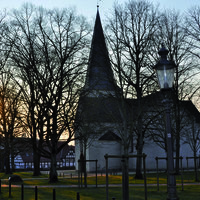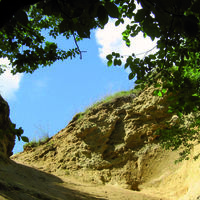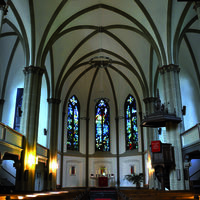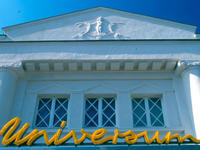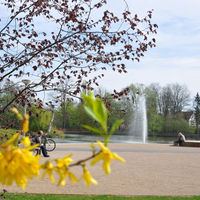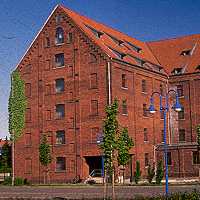City Porträt of Bünde
Commercial development
Spend time browsing or shopping in this attractive town
A stroll round the traditional Bünde market is a must for visitors. This takes place in the market square in Marktstraße three times a week on Tuesdays, Thursdays and Saturdays and is well-known and well-loved throughout the region. The wide variety of goods for sale include regional specialities like Westphalian ham, sausage, meat, poultry, fish and textiles as well as bread and bakery products, eggs, dairy produce, honey, fruit, vegetables and flowers. The market is open every Tuesday, Thursday and Saturday throughout the year from 07:00 until 13:00.
Traditions and festivals
Sport and exercise in Bünde
The culture scene in Bünde
Hospitality in Bünde
Places of interest to visit in the town
The German tocacco and cigar museum is located in the Striediekschen Hof, built in 1830. The 2,230 exhibits and 31 interactive media stations give an insight into the cultural history of tobacco. The origins of tobacco in connection with the indigenous population of America and the route of this weed, unknown before Christopher Columbus' voyages of discovery, to the "Old World" are themes covered by the cultural history. Interesting facts can be discovered about tobacco as a form of medication and about the spread of the various methods of tobacco consumption. There are more than 500 pipes and 200 smoking accessories on display, which give interesting glimpses into the social significance and the consumption of tobacco previous centuries.
The Doberg Museum – the geological museum of eastern Wesphalia-Lippe is housed in a modern building in the same area. The Oligocene period is brought to life here, a time when 30 million years ago the waves of an earlier North Sea surged against the cliffs of the Teutoburg Forest. Fascinating fossils centred on the Herford Lias Basin and Wiehen Mountains can be seen in the section entitled "The Mesozoic period on the southern edge of the North German Basin". The most important exhibits from more recent periods of the Oligocene era are the Doberg skeleton of the famous Bünde manatee and the skull of equally famous toothed whale.
The exhibits in the museum of local history in the Hurlbrinksches Haus and the Spieker next door are tools and equipment related to the linen weaving industry and show aspects of life in the town at the end of the 19th and beginning of the 20th centuries. The reconstruction of a typical corner shop as it would have been around the first half of the 20th century is particularly interesting.
32257 Bünde
Telefon: 05223 161-750
Telefon: 05223 161-751
E-Mail schreiben
www.buende.de/museum
Nachricht schreiben
Adresse exportieren
2. St Laurentius Church
St Laurentius' church in Bünde is one of the oldest churches founded in Westphalia. An ancient deed dating from the year 853 shows that this church together with a farming settlement called "Buginithi" existed in the time of Louis the Pious (778-840). Following much building and alteration work, the late Romanesque transept was completed in the 13th century and has substantially survived intact. The west tower is probably of an earlier date. The building is now used by the Lutheran church and has been a listed building since 1985. St Laurentius' Church is certainly well worth a visit, but there are other things to see as well. A walk round the square in front of the church reveals some ancient chestnut, oak and lime trees which also give that air of timelessness.
32257 Bünde
http://www.lydia-gemeinde.de
Adresse exportieren
Die Laurentiuskirche in Bünde zählt zu den ältesten Kirchengründungen in Westfalen. Anhand eines Urkundentextes aus dem Jahre 853 wurde rekonstruiert, dass diese Kirche zusammen mit einer Hofsiedlung "Buginithi" schon zurzeit Ludwig des Frommen (778-840) bestanden hat.
Nach mehreren Bau- und Umbaumaßnahmen entstand dann im 13. Jahrhundert der noch heute im Kern erhaltene spätromanische Kreuzsaal. Der Westturm datiert wahrscheinlich früher. Seit 1984 steht das älteste Bauwerk Bündes unter Denkmalschutz. Die im Mittelpunkt der Stadt errichtete Kirche ist ein Zeugnis der beginnenden Bünder Stadtwerdung. Bei der 1979 – 1981 erfolgten Renovierung des Innenraumes der Kirche wurden auch Ausgrabungen vorgenommen, um vielleicht Anhaltspunkte über das Alter des Kirchengebäudes zu bekommen. Es wurden aber lediglich einige gut erhaltene Fundamentreste gefunden, aus denen man aber schließen kann, dass sie wahrscheinlich aus der Zeit Karls des Großen stammen, also etwa um 800 nach Christus. Diese Fundamente könnten der Unterbau für ein damals schon vorhandenes Kirchengebäude sein.
3. Hof Rahning and Haus Dahlkötter
Hof Rahning was once a town farmhouse dating from 1677. This imposing, half-timbered listed building is in Bahnhofstraße, just across from St Laurentius' Church. Dahlkötter, the four-storey half-timbered house next door is thought to have been built in 1555. If this is the case, the house is the oldest building in Bünde. It was originally built simply as a farmhouse. An extension on the west side served as a stable. The cellar beneath the house, with its small windows, still covered with a grille, was once used by the police as a jail. Today this building is occupied by the registry office.
4. Doberg – a "sea water aquarium in stone",
Doberg lies to the south-east of Bünde and consists of sand and marl, the deposits left by the original North Sea that covered this area about 30 million years ago. This is the only site in the whole of Europe where all the strata of that period are still intact. Doberg is, therefore, of great scientific significance. Huge turtles, gigantic sharks, slender toothed whales, manatees, numberless snails, sea urchins and crabs milled around in the warm tides of the wide ocean. This complex ecology can still be seen in its fossilised form. The most significant finds from Doberg include the skeleton of a manatee and the 1 metre-long skull of a toothed whale.
32257 Bünde
Der im Südosten von Bünde gelegene Doberg besteht aus Sand und Mergel als Ablagerungen einer Ur-Nordsee, die hier vor ca. 30 Millionen Jahren das Land bedeckte. In ganz Europa ist nur hier die gesamte Schichtenfolge aus jener Zeit erhalten geblieben. Daher ist der Doberg von herausragender wissenschaftlicher Bedeutung. Dort tummelten sich in den warmen Fluten eines weiten Meeres einst riesige Schildkröten, gigantische Haie, schlanke Zahnwale, Seekühe, unzählige Schnecken, Seeigel und Krebse. Diese komplexe Lebenswelt finden wir heute in versteinerter Form vor. Zu den bedeutendsten Fundstücken aus dem Doberg gehören das Skelett einer Seekuh und ein fast 1 m langer Zahnwalschädel.
5. St Paul's Church
St Paul's Church was built between 1869 and 1873 in the neo-gothic style as a hall church with three naves. The church was built in Weser sandstone, and has a massive tower on it west front. It was originally built as a preaching church intended to accommodate 1,200 people, and so the pulpit stands in the middle of the attentive congregation. This imposing building bears witness to the growth of the Lutheran congregation in Bünde and the development of the town in the mid-19th century. St Paul's Church has been a listed building since 1986. As well as services of worship and other ecclesiastical events, the church regularly hosts classical concerts which feature artists from Germany and abroad.
32257 Bünde
http://www.pauluskirche-buende.de
Adresse exportieren
Die Pauluskirche ist eine von 1869 bis 1873 im neugotischen Stil errichtete dreischiffige Hallenkirche (Baumeister: W. Moelle aus Minden). Die aus Wesersandsteinen gebaute Kirche, mit einem wuchtigen Turm an der Westseite, wurde seinerzeit für 1.200 Personen als sogenannte Predigtkirche errichtet, das heißt, die Kanzel steht inmitten der zuhörenden Gemeinde. Der imposante Eindruck des Bauwerks zeugt vom Wachstum der evangelisch-lutherische Bünder Kirchengemeinde und der Stadtentwicklung in der Mitte des 19. Jahrhunderts. Die Pauluskirche steht seit 1986 unter Denkmalschutz.
6. Universum
The Universum Cinema successfully combines the atmosphere of a 50s cinema with the latest technology. The cinema can seat 220 patrons and is a centre for intimate theatre and cinema. It is open six days a week and presents entertainment for all tastes. In Humphreys, the bistro attached to the cinema, can meet in a sociable setting to chat about what they have just seen or are about to see.
Hauptstraße 9
32257 Bünde
Telefon: 05223 178888 (Universum BetriebsGmbH)
Telefax: 05223 178877
E-Mail schreiben
http://www.universum.tv
Nachricht schreiben
Adresse exportieren
"Der Glöckner von Notre Dame" war der erste Film im 1924 erbauten Lichtspielhaus Wittekind. Die expressionistisch gestaltete Eingangsfront ist ein Blickfang und weist mit der Fassadengestaltung und der Säulenstellung auf die Tradition hin, in der die Lichtspielhäuser der damaligen Zeit gebaut wurden. Die Tradition der bürgerlichen Saalbauten spiegelt sich auch in der Innenraumarchitektur mit Bühne und Empore wider.
Der Förderverein Universum rettete das bekannte Kino im Stadtteil Ennigloh vor dem Verfall. Mit großem bürgerschaftlichen und persönlichen Engagement vieler Vereinsmitglieder und Unterstützung der Stadt Bünde entstand ein Veranstaltungsort im Stil der 50er Jahre nicht nur für Filmvorführungen. Das UNIVERSUM präsentiert unendliche Unterhaltung von Kino über Konzert bis Kabarett.
Das Universum-Filmtheater ist heute ein modernes Veranstaltungszentrum mit circa 220 - 240 Plätzen. Das Haus wird vom Förderverein Universum geführt.
Mit seiner Einrichtung als Kino im Stil der 50er Jahre und mit seinem attraktiven Programmangebot ist das Universum ein kulturelles "Highlight" für Bünde und die Region.
7. City Hall "Stadtgarten"
For over 100 years the Stadtgarten had been the focus for social and cultural events in Bünde. Completely renovated in 1997, the main hall can seat up to 2,400 people. It is the venue for large-scale performances, celebrations, concerts, theatre, musicals, ballet, dance and folk-dancing, rock & pop, folk music, trades fairs, conferences etc.
32257 Bünde
Telefon: 05223 178888
http://www.stadtgarten.tv/
Adresse exportieren
8. Steinmeisterpark
A green oasis in the middle of the town: The 2.5 hectare Steinmeisterpark is barely 10 minutes walk away from the shopping area. Benches along a network of paths invite the visitor to sit and rest for a moment or two. This is the place to recover from the stress of everyday life and to enjoy the laughter of children in the play area at the edge of the park or simply to watch the ducks swimming along. The Steinmeister pond is the only remaining fish pond of what at the end of the 19th century were 38 ponds between Lübbecker Straße and Bismarckstraße first created as fish farms. Fish farming was introduced by August Steinmeister, the son of the co-founder of the Bünde cigar industry. There is no record of why fish farming did not survive in Bünde. The little house at the edge of the pond are a reminder that the fish farmer once lived here.
32257 Bünde
Eine grüne Oase inmitten der Stadt: Der 2,5 ha große Steinmeisterpark liegt kaum 10 Minuten Fußweg von der Einkaufszone entfernt. Entlang ausgedehnter Spazierwege laden zahlreiche Bänke zum Ausruhen und Verweilen ein. Hier erholt man sich vom Alltagsstress, freut sich am Lachen der Kinder auf dem Spielplatz am Rande der Parkanlage oder schaut einfach nur den Enten beim Baden zu. Der Steinmeister-Teich ist der letzte von ursprünglich 38 Fischteichen, die Ende des 19. Jahrhunderts in dem gesamten Areal zwischen Lübbecker Straße und Bismarckstraße zur Fischaufzucht angelegt wurden. Initiator der Bünder Fischzucht war August Steinmeister, der Sohn des Mitbegründers der Bünder Zigarrenindustrie. Warum sich die Fischzucht in Bünde nicht durchsetzen konnte, ist nicht überliefert. Noch heute erinnert das kleine Häuschen am Rande des Teiches an den damals hier lebenden Fischzuchtmeister.
9. The tobacco warehouse
The striking four-storey red-brick building with its two attic floors was built in 1896 in the industrial style of that time as a tobacco warehouse. This is the only remaining warehouse in Westphalia and its appearance is reminiscent of the warehouse buildings of the north German Hanseatic cities. In 1986, the Bünde town council made the tobacco warehouse a listed building and it has subsequently been completely restored. This industrial monument is still used as a tobacco warehouse.
32257 Bünde
Der wuchtige, rote Backsteinbau ist ein markantes und vertrautes Wahrzeichen für unsere Stadt. 1896 wurde der Speicher durch die Firma Leopold Engelhardt & Biermann als Tabaklagerhaus erbaut. Er hat vier Vollgeschosse und zwei Dachgeschosse. Unterkellert ist er nicht. Seine Architektur entspricht den Speicherbauten der deutschen Hafenstädte, das Sichtmauerwerk aus roten Ziegelsteinen, die Gliederung seiner Fassade durch Pfeilervorbauten. Die Dachform und der Lastenaufzug an der Giebelseite verweisen auf diese Provenienz und geben dem ganzen Bau ein leichtes hanseatisches Aussehen. Von seinen Erbauern wurde sein Standort in unmittelbarer Nähe des Güterbahnhofes gewählt. Somit konnten die Transportwege gering gehalten werden.
1930 gab die Firma Engelhardt & Biermann den westfälischen Produktionsbereich auf und damit auch den Tabakspeicher in Bünde. Er ging mit dem gesamten Betriebsgelände einschließlich der Fabrikgebäude in den Besitz der Deutschen Reichsbahn über. Von deren Rechtsnachfolger, der Deutschen Bundesbahn, erwarb die Stadt Bünde im Jahre 1973 das Grundstück mit den dazugehörigen Gebäuden. 1974 wurde das Fabrikgebäude abgerissen, der Tabakspeicher blieb stehen. Von verschiedenen Bünder Zigarrenfabriken wurde er zur Tabaklagerung genutzt. Zwischenzeitlich diente er auch als Möbellager. Heute dient er weiterhin als Tabaklager für die Zigarrenfabrik André. 2 Geschosse nutzt das Deutsche Tabak- und Zigarrenmuseum als Magazin. Hier lagern Maschinen der Zigarrenfabrikation, mit denen sich die maschinelle Verarbeitung des Tabaks und die Zigarrenherstellung vorzüglich präsentieren ließen.
Seit dem 14.7.1986 ist der Speicher eingetragenes Denkmal und damit sein Bestand durch Gesetz geschützt. Von 1990 bis 1992 wurde der Tabakspeicher im Rahmen denkmalschützerischer Maßnahmen vollständig renoviert.
10. The Bünde Music School
The Bünde Music School was founded in 1958 as part of the youth music movement in the Herford district and was taken over in 1970 into the care of the local authority. Since 1983 it has been based in the former administration building in Ennigloh, a handsome art nouveau building with a Renaissance-style south gable built in 1902. Around 1,100 pupils receive instruction here in early and basic musical education, music theory and instrumental or vocal tuition in a total of 25 subjects. The musical skills the pupils acquire can be expressed and developed in the symphony orchestra, chamber music groups, the big band or other ensembles.
Schulleiter
Amtshausplatz 1
32257 Bünde
Telefon: 05223 497180
Telefax: 05223 497199
E-Mail schreiben
musikschule.buende.de
Nachricht schreiben
Adresse exportieren
11. Public Library
The library holds around 40,000 books, CDs, cassettes and CD-ROMs for every taste and every interest which are available for borrowing.
The library also hosts a varied cultural programme: Story-telling sessions, book quizzes and puppet plays for children, plus lectures and readings and lectures etc. Just come drop by, it's well worth a look!
32257 Bünde
Telefon: 05223 161-650
E-Mail schreiben
https://buende.bibliotheken-in-owl.de/
Telefax: 05223 99340-29
Nachricht schreiben
Adresse exportieren
Zusatzinformation
geschlossen
Dienstag:
10:00-13:00 und 15:00-18:00 Uhr
Mittwoch:
13:00-16:00 Uhr
Donnerstag:
10:00-13:00 und 15:00-18:00 Uhr
Freitag:
10:00-13:00 und 14:00-16:00 Uhr
City Porträt of Bünde
Post Code 32257
Prefix number +49 52 23
District of Herford, administrative district of Detmold, Land of North Rhine-Westphalia.
Bünde municipal administration, Bahnhofstr. 13 + 15, 32257 Bünde,
P.O. Box 27 49 • 32227 Bünde
Phone 1 61-0, Fax 1 61-3 51
Citizens Advice Bureau in town hall, phone 161-435,
Fax 161-352
Internet: www.buende.de
E-mail: info@buende.de
Urban area
Urban area 5,930 hectares
North-south extent 10.7 km
East-west extent 11.0 km
Altitude 59 -175 metres above sea level.
Distances:
Administrative centre, Herford 12 km
Bielefeld 22 km
Osnabrück 39 km
Hannover 100 km
Culture and events centres
Stadtgarten (and Stadthalle), Universum Cinema, Dammhaus, Town Hall, Library, Music school, community schools Bünde-Mitte and Bünde-Nord, events in churches, light shows in Bünde.
Schools
8 primary schools, 1 secondary school, 2 secondary schools, 2 grammar schools, 1 comprehensive school (Federation of Comprehensive Schools, Bünde/Kirchlengern, 1 special school for children with learning difficulties, 2 vocational schools for the Herford district (specialist school for technology and therapeutic pedagogy, school of business studies), adult education centre in Herford district.
Sport and leisure
1 heated open-air swimming pool, 1 indoor swimming pool, 19 sports and gymnastics halls, 20 sports fields and outdoor sports facilities, 2 tennis courts, 3 shooting ranges, 2 riding facilities, angling on the Else (more than 40 different species of fish), cycle hire, bike park at the station.
Health and social life
1 hospital (400 beds), 1 psychiatric clinic, 11 general practitioners, 46 specialists, 22 dentists, 8 practitioners of alternative medicine, 4 midwives, 3 veterinary surgeons, 13 pharmacies, medical and health centres, 19 day nurseries, 34 children's playgrounds, 1 youth hostel, 1 youth leisure centre, 4 residential care homes for the elderly, 1 day care centre with welfare centre, 10 day centres for the elderly, support centres for foreigners and refugees and numerous churches.
Bünde is mobile
The Bünde area is on the 375 timetable stretch of the Hengelo-Löhne line and so has excellent long-distance passenger rail connections to Amsterdam/Münster and Hanover/Berlin.
LPT – local public transport
Bünde railway station has a direct connection to the Bünde city bus services. Other regional bus services provided by the Minden- Herforder Verkehrsservice GmbH start from the central bus station. Modern city buses run on 4 routes through the Bustedt, Dünne, Ennigloh, Hunnebrock, Südlengern and Spradow districts, serving around 35,000 residents. Information on fares and timetables can be obtained from the bus office or the Treffpunkt bus stop. The mobility centre is also here and can supply information on all LPT services.
City bus office
Museumsplatz 9
32257 Bünde
Telefon: 05223 161-722
E-Mail schreiben
http://www.buender-busse.de/
Nachricht schreiben
Adresse exportieren
Cycling in Bünde
The nationally recognised spa resort of Randringhausen with its health cure district
Town Twinning
Since 1968 Bünde has been twinned with the Finnish town of Jakobstad/Pietarsaari, a coastal town on the Gulf of Bothnia. The twin towns share a similar history of commercial development. The tobacco industry was also dominant in Jakobstad at one time. Jakobstad has a population of around 20,000. The town twinning thrives on regular contact on both a large and a small scale.
In 1990, Bünde was also twinned with Leisnig in Saxony. This small mining town with a population of around 9,000 and situated in an attractive area of the Freiberg basin has a remarkable history. Cigars were also once produced in Leisnig. The Leisnigers go for superlatives in exactly the same way as the Bünder (enormous cigars in the museum). The Leisniger giant's boot (shoe size 330) is unique and has found its way into the Guinness Book of Records.
Kontakt
Bahnhofstraße 13+15
32257 Bünde
Telefon: 05223 161-389
Fax: 05223 1616389
E-Mail oder Kontaktformular

